Doctoring Sales – IELTS Reading Answers
7 min read
Updated On
-
Copy link
Table of Contents

Limited-Time Offer : Access a FREE 10-Day IELTS Study Plan!
The Academic passage ‘Doctoring Sales’ is a reading passage that appeared in an IELTS Test.
Ideally, you should not spend more than 20 minutes on a passage. Let’s see how easy this passage is for you and if you’re able to make it in 20 minutes. If not, try more IELTS reading practice tests from IELTSMaterial.com
Doctoral Sales

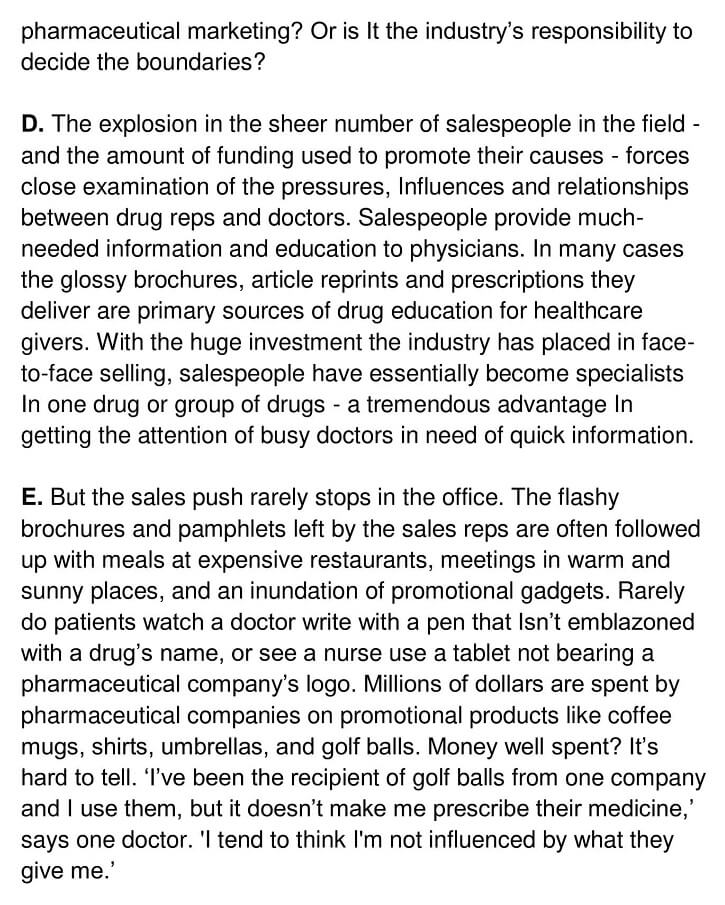
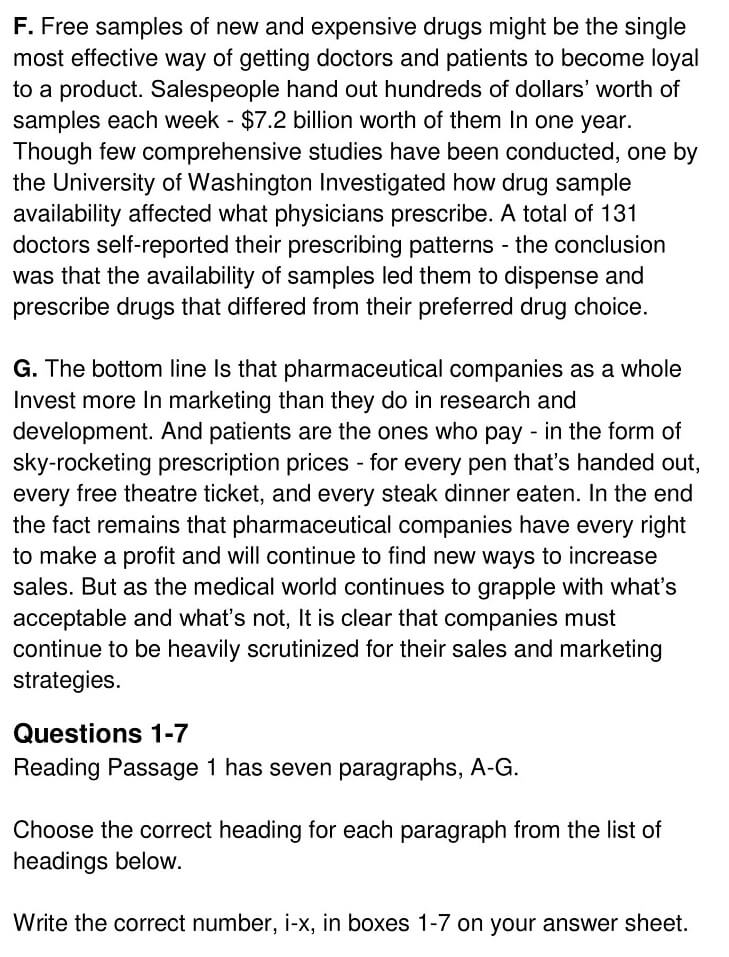
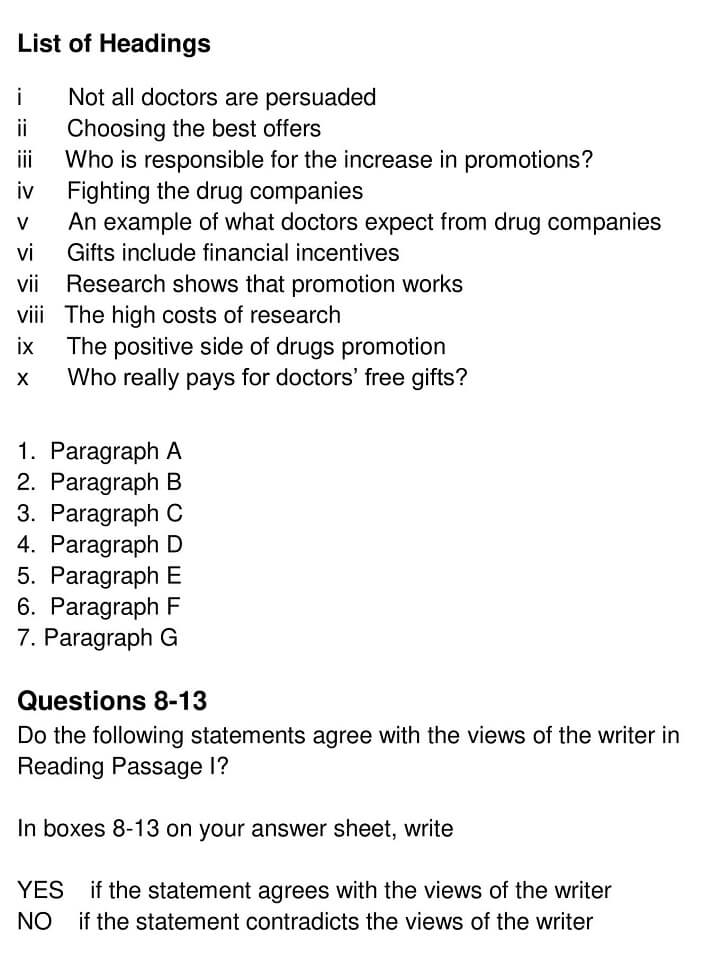
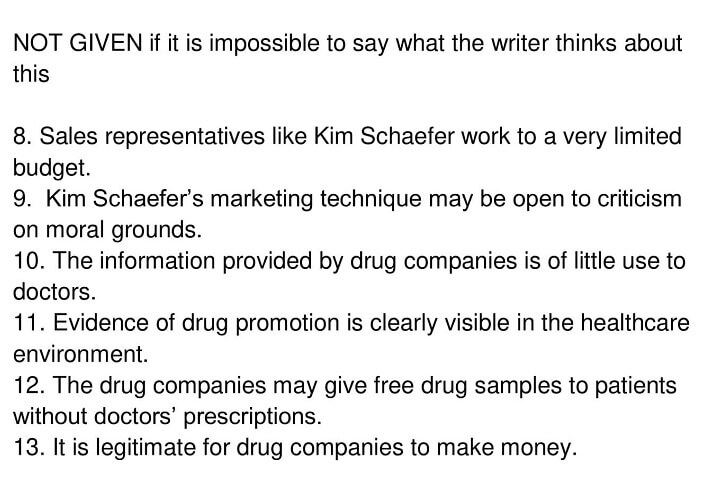
Answers
| Question number | Answer | Explanation |
|---|---|---|
| 1 | v | Paragraph A puts forward an example of what doctors expect. A few months ago Kim Schaefer, sales representative of a minor global pharmaceutical company, walked into a medical center in New York to bring information and free samples of her company’s latest products. That day she was lucky – a doctor was available to see her. ‘The ‘last rep offered me a trip to Florida’ (what drug companies offer to doctors). What do you have?’ the physician asked. He was ‘only half joking’ (he expects more from drug companies). Hence, the answer is v (An example of what doctors expect from drug companies). |
| 2 | vi | Paragraph B mentions that on any given day what ‘Schaefer’ (medicine representatives) can offer is typical for today’s drugs rep – ‘a car trunk full of promotional gifts and gadgets’, ‘a budget that could buy lunches and dinners for a small country hundreds of free drug samples and the freedom to give a physician $200 to prescribe her new product to the next six patients who fit the drug’s profile’ (financial incentives). And she also has a ‘few $1,000 honoraria’ to offer in exchange for doctors’ attendance at her company’s next educational lecture. Hence, the answer is vi (Gifts include financial incentives). |
| 3 | iii | Paragraph C talks about selling pharmaceuticals being a daily exercise in ethical judgment. Salespeople like Schaefer ‘walk the line between the common practice of’ buying a prospect’s time with a free meal, and ‘bribing doctors’ to prescribe their drugs. They work in an industry highly criticized for its sales and marketing practices, but ‘find themselves in the middle of the age-old chicken-or-egg question’ – businesses won’t use strategies that don’t work. Due to this confusing state, the writer asks the questions ‘are doctors to blame for the escalating extravagance of pharmaceutical marketing?’ Or is it the ‘industry’s responsibility to decide the boundaries’?- because even he/she is not sure. Hence, the answer is iii (Who is responsible for the increase in promotions?). |
Unlock Answers
| 4 | ix | Paragraph D states that salespeople ‘provide much-needed information and education to physicians’. In many cases, the glossy brochures, article reprints and prescriptions ‘they deliver are primary sources of drug education for healthcare givers’. With the huge investment the industry has placed in face-to-face selling, ‘sales people have essentially become specialists in one drug or group of drugs’ – a tremendous advantage in getting the attention of busy doctors in need of quick information. Hence, the answer is ix (The positive side of drugs promotion). |
| 5 | i | Paragraph E points out that ‘rarely do patients watch a doctor write with a pen that isn’t emblazoned with a drug’s name’ (it is rare but sometimes doctors are not influenced by the drug companies). Moreover, it is supported by an example of a doctor stating, ‘‘I’ve been the recipient of golf balls from one company’ and I use them, but it ‘doesn’t make me prescribe their medicine’,’ says one doctor.’ I tend to think ‘I’m not influenced’ (he may not be persuaded) by what they give me.’ Hence, the answer is i ( Not all doctors are persuaded). |
| 6 | vii | Paragraph F informs that ‘free samples of new and expensive drugs’ (promotion through free products) might be the ‘single most effective way of getting doctors’ and patients to ‘become loyal to a product’. Though ‘few comprehensive studies’ have been conducted, one by the University of Washington investigated ‘how drug sample availability affected what physicians prescribe’. A total of 131 doctors self-reported their prescribing patterns-the conclusion was that the ‘availability of samples led them to dispense and prescribe drugs that differed from their preferred drug choice’ (promotion works). Hence, the answer is vii (Research shows that promotion works). |
| 7 | x | Paragraph G tells us that the bottom line is that pharmaceutical companies as a whole invest more in marketing than they do in research and development. ‘Patients are the ones who pay’ (real payers) -in the ‘form of sky-rocketing prescription prices’ – for ‘every pen that’s handed out, every free theatre ticket, and every steak dinner eaten’. Hence, the answer is x (Who really pays for doctors’ free gifts?). |
| 8 | NO | Paragraph B confirms that ‘on any given day Schaefer can offer’ – ‘a car trunk full of promotional gifts and gadgets’, a ‘budget that could buy lunches and dinners for a small county’, ‘hundreds of free drug samples’, and the ‘freedom to give a physician $200 to prescribe her new product to the next six patients who fit the drug’s profile’. Moreover, she also ‘has a few $ 1,000 honoraria to offer in exchange for doctors’ attendance at her company’s next educational lecture’. As the statement contradicts the information, the answer is NO. |
| 9 | YES | Paragraph C states that ‘selling pharmaceuticals’ is a daily ‘exercise in ethical judgment’ (open to criticism on moral grounds). ‘Salespeople like Schaefer walk’ the line ‘between the common practice of buying a prospect’s time with a free meal’ and ‘bribing doctors to prescribe their drugs’. They ‘work in an industry highly criticized for its sales and marketing practices’. As the statement agrees with the information, the answer is YES. |
| 10 | NO | Paragraph D provides the information that ‘salespeople’ offer ‘much-needed information and education to physicians’ (information provided by drug companies or their representatives). In many cases, the ‘glossy brochures, article reprints and prescriptions they deliver’ are ‘primary sources of drug education for healthcare givers’. As the statement contradicts the information, the answer is NO. |
| 11 | YES | Paragraph E brings out the fact that at most times ‘patients watch a doctor write with a pen emblazoned with a drug’s name’ (evidence of drug promotion), or see ‘a nurse use a tablet bearing a pharmaceutical company’s logo’ (evidence of drug promotion). Millions of dollars are spent by pharmaceutical companies on promotional products like coffee mugs, shirts, umbrellas, and golf balls. As the statement agrees with the information, the answer is YES. |
| 12 | NOT GIVEN | The first sentence of paragraph F mentions that ‘free samples’ of new and expensive drugs ‘might be’ (possibility) the ‘single most effective way of getting’ doctors and ‘patients’ to ‘become loyal to a product’. In this portion, it is hinted that there is a possibility that the drug companies may provide free samples to patients, but there is no credible proof that they do it and that too without a doctor’s prescription. Hence, the answer is NOT GIVEN. |
| 13 | YES | In the beginning of paragraph G, it is given that the ‘pharmaceutical companies’ as a whole ‘invest more in marketing than’ they do ‘in research and development’. The main reason is because the ‘pharmaceutical companies have every right to make a profit’ (legitimate for drug companies) and will ‘continue to find new ways to increase sales’ (to make money). As the statement agrees with the information, the answer is YES. |
Check More IELTS Reading Answers
Also check :
Practice IELTS Reading based on question types

Start Preparing for IELTS: Get Your 10-Day Study Plan Today!
Recent Articles

Nehasri Ravishenbagam

Haniya Yashfeen

Haniya Yashfeen

Haniya Yashfeen
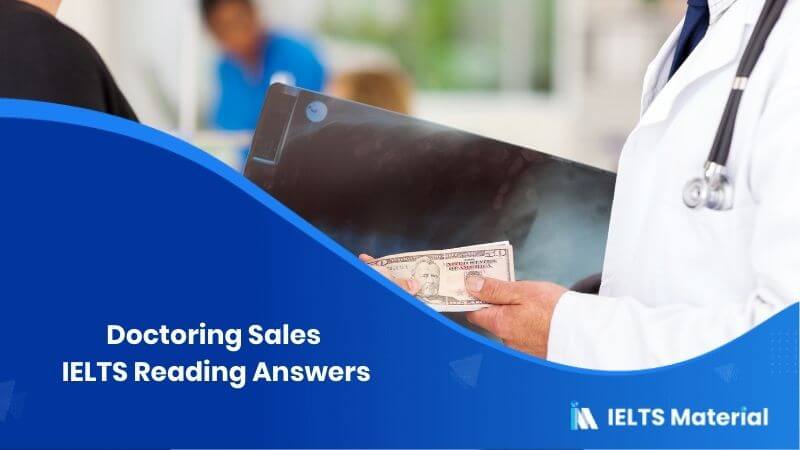



Post your Comments